Dr. Vadym Zayets
v.zayets(at)gmail.com
My Research and Inventions
click here to see all content |

Dr. Vadym Zayetsv.zayets(at)gmail.com |
|
 |
more Chapters on this topic:IntroductionTransport Eqs.Spin Proximity/ Spin InjectionSpin DetectionBoltzmann Eqs.Band currentScattering currentMean-free pathCurrent near InterfaceOrdinary Hall effectAnomalous Hall effect, AMR effectSpin-Orbit interactionSpin Hall effectNon-local Spin DetectionLandau -Lifshitz equationExchange interactionsp-d exchange interactionCoercive fieldPerpendicular magnetic anisotropy (PMA)Voltage- controlled magnetism (VCMA effect)All-metal transistorSpin-orbit torque (SO torque)What is a hole?spin polarizationCharge accumulationMgO-based MTJMagneto-opticsSpin vs Orbital momentWhat is the Spin?model comparisonQuestions & AnswersEB nanotechnologyReticle 11
|
Parametric mechanism of Magnetization Reversal. part 3. Parametric parameter 2: Anisotropy field. Spin and Charge TransportAbstract:A parameter, which is used for an efficient parametric magnetization reversal, is the anisotropy field Hani. The anisotropy field is characterizes the strength of the perpendicular magnetic anisotropy (PMA) of the nanomagnet. There are two parameters, which can modulate the anisotropy field. The 1st parameter is the electron current flowing through the nanomagnet. The 2nd parameter is a gate voltage. Each of parameters can be used for the parametric magnetization reversal.When the anisotropy field is modulated at a frequency close the resonance frequency ωL of the magnetization precession (Larmor frequency), the angle of the magnetization precession increases due to the parametric precession pumping, which leads to the magnetization reversal.The strength of the PMA and therefore the magnitude of the anisotropy field depends substantially on the electrical current flowing through the nanomagnet and on a gate voltage applied to the nanomagnet interface. Each or both of these dependencies can be used for the parametric reversal.This type of parametric magnetization reversal may occur only when an external in-plane magnetic field is applied to the nanomagnet and the magnetization turns away from its equilibrium direction along the easy magnetic axis. Only In this case, the modulation of the anisotropy field changes the magnetization direction.When a electron current flows through a ferromagnetic nanomagnet, spin- polarized electrons are accumulated at nanomagnet boundaries due to the Spin Hall effect.
The most unique feature of the parametric pumping is the ability to induce the magnetization precession and the magnetization reversal by a DC electrical current when there is no external parameter modulated at the precession frequency. This unique effect occurs only in a magneto-resistant structure when the electrical current is modulated by the magnetization precession and the modulated current itself modulates the anisotropy field, which parametrically enhances the same precession. There is a positive feedback loop, which is able to enhance the precession of a tiny thermal oscillation until a magnetization reversal occurs.page creation date: start May 2021-Content
6. Explanation video
|
|
|
||
|---|---|---|
(important): spin direction of accumulated conduction electrons is along the spin direction of nanomagnet magnetization |
||
|
||
| An electric current, which flow through the nanomagnet, creates spin accumulation of spin-polarized conduction electrons (green balls) due to the Spin Hall effect and Ordinary Hall effect (See here). the magnetic field due to the current- induced spin accumulation is perpendicular to the spin of localized electrons (blue ball). As a result, the spin of localized electrons (magnetization) is tilted towards the in-plane direction. | ||
| (fact) Anisotropy field increases when an external magnetic field is applied perpendicularly to the plane (See here) | ||
| click on image to enlarge it |
 Ability to change the magnetization direction by an electrical current. This is achieved by using two properties:
Ability to change the magnetization direction by an electrical current. This is achieved by using two properties:
(RF modulated current: parametric resonance) The RF current modulates the Hani. When frequency and phase of the modulation of the anisotropy field Hani is in the resonance with the magnetization precession, there is an enhancement of magnetization oscillations, which leads to the magnetization reversal (See details below)
The RF current modulates the Hani. When frequency and phase of the modulation of the anisotropy field Hani is in the resonance with the magnetization precession, there is an enhancement of magnetization oscillations, which leads to the magnetization reversal (See details below)
(DC electrical current: positive feedback loop) ![]() Under a DC current a thermally- initiated magnetization oscillation is enhanced to a substantial magnetization precession and further to the magnetization reversal due to positive feedback loop. The positive feedback loop is: (1) a small magnetization precession---> (2) modulation of the magneto- resistance ---> (3) modulation of electrical current ---> (4) modulation of the anisotropy field Hani---> (5) parametric enhancement of magnetization precession ---> (6) magnetization precession at a larger precession angle ---> (2) --->(3) ---> (4) ---> (5) --->(6) --> (2)
Under a DC current a thermally- initiated magnetization oscillation is enhanced to a substantial magnetization precession and further to the magnetization reversal due to positive feedback loop. The positive feedback loop is: (1) a small magnetization precession---> (2) modulation of the magneto- resistance ---> (3) modulation of electrical current ---> (4) modulation of the anisotropy field Hani---> (5) parametric enhancement of magnetization precession ---> (6) magnetization precession at a larger precession angle ---> (2) --->(3) ---> (4) ---> (5) --->(6) --> (2)
(origin of dependency of anisotropy field on electrical current): ![]() The perpendicular magnetic anisotropy (PMA) in a nanomagnet exists due to the unique magnetic properties (See here) of localized d-electrons at the nanomagnet interface. The spin- polarized conduction electrons are accumulated at boundary of the nanomagnet under an electrical current due to the Spin Hall effect. The spin accumulation affects the magnetic properties of the localized d-electrons, which leads to the change of the PMA strength and therefore to the modulation of Hani.
The perpendicular magnetic anisotropy (PMA) in a nanomagnet exists due to the unique magnetic properties (See here) of localized d-electrons at the nanomagnet interface. The spin- polarized conduction electrons are accumulated at boundary of the nanomagnet under an electrical current due to the Spin Hall effect. The spin accumulation affects the magnetic properties of the localized d-electrons, which leads to the change of the PMA strength and therefore to the modulation of Hani.
(origin of dependency of anisotropy field on gate voltage):![]() The gate voltage affects the magnetic properties of the localized d-electrons at the nanomagnet interface, which leads to the change of the PMA strength and therefore to the modulation of Hani. This effect is called the Voltage Controlled Magnetic Anisotropy (VCMA). See here for details
The gate voltage affects the magnetic properties of the localized d-electrons at the nanomagnet interface, which leads to the change of the PMA strength and therefore to the modulation of Hani. This effect is called the Voltage Controlled Magnetic Anisotropy (VCMA). See here for details
(high- precision measurement of the anisotropy field) ![]() (see here)
(see here) ![]()

 (explanation in short)
(explanation in short) ![]()
(point 1: magnetization tilting angle vs. PMA strength): In an equilibrium, the magnetization of a nanomagnet is perpendicular- to- plane. When an external in-plan magnetic field is applied, the magnetization is tilted towards the external field. The tilting angle depends on the field strength and the strength of the PMA. The tilting angle is larger when the in-plane field is larger and the PMA strength is smaller.
In an equilibrium, the magnetization of a nanomagnet is perpendicular- to- plane. When an external in-plan magnetic field is applied, the magnetization is tilted towards the external field. The tilting angle depends on the field strength and the strength of the PMA. The tilting angle is larger when the in-plane field is larger and the PMA strength is smaller.
(point 2: modulation of magnetization tilting angle): When the PMA strength is modulated either by a current or by a gate voltage, the magnetization tilting angle is changing following the modulation strength.
When the PMA strength is modulated either by a current or by a gate voltage, the magnetization tilting angle is changing following the modulation strength.
(point 3: parametric resonance): When the frequency and phase of the modulation of the magnetization angle are in the resonance with the magnetization precession, the magnetization precession angle resonancely increases, which eventually leads to the magnetization reversal.
When the frequency and phase of the modulation of the magnetization angle are in the resonance with the magnetization precession, the magnetization precession angle resonancely increases, which eventually leads to the magnetization reversal.

(similarity 1): strength of Perpendicular Magnetic Anisotropy (PMA) and therefore anisotropy field Hani are modulated in both mechanisms
(similarity 2): External in-plane magnetic field H|| is required in both mechanisms

(difference 1): an electrical current flows for mechanism 1. The current flow is not required for the second mechanism.
(difference 2) both mechanisms can be used as a par metric recording for MRAM. However, mechanism 1 can be used in a 3-terminal MRAM, but mechanism 2 can be used in
Modulation of Perpendicular magnetic anisotropy and as a result Hani |
||||||||||||
|---|---|---|---|---|---|---|---|---|---|---|---|---|
Measurements |
||||||||||||
|
||||||||||||
| click on image to enlarge it |
mechanism 1: Dependence of the anisotropy field on current
| mechanism 1: dependence of Hani on current j | mechanism 2: dependence of Hani on gate voltage | |
|---|---|---|
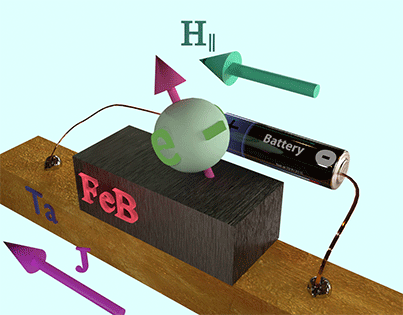 |
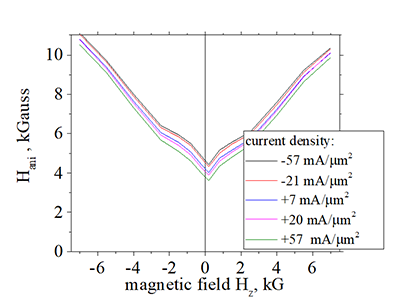 |
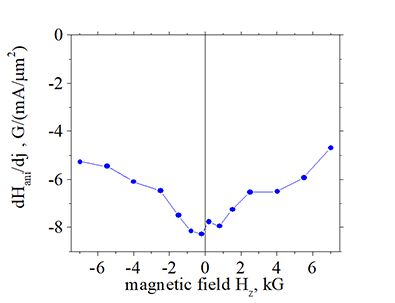 |
sample |
||
| sample: Volt40B R21A (See here) |
Origin
Application:
|
|||||||||
| In both cases | |||||||||
| click on image to enlarge it |
Gate
| mechanism 2: dependence of Hani on gate voltage | ||
|---|---|---|
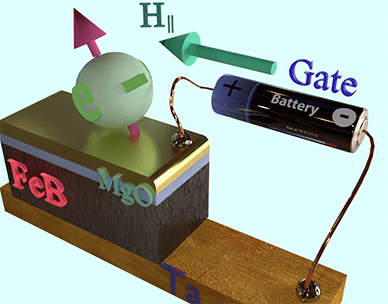 |
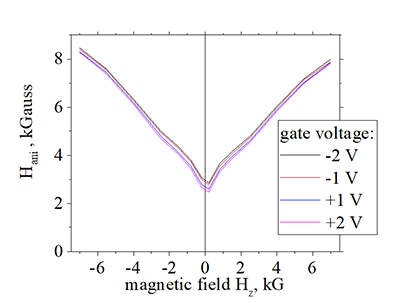 |
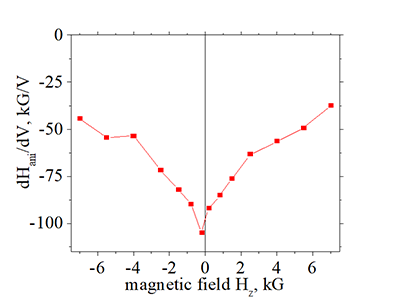 |
sample |
||
| sample Volt54A L74C (See sample details here) |
![]()
![]() I am strongly against a fake and "highlight" research
I am strongly against a fake and "highlight" research ![]()
![]()
![]()
![]()
![]()
![]()
I will try to answer your questions as soon as possible